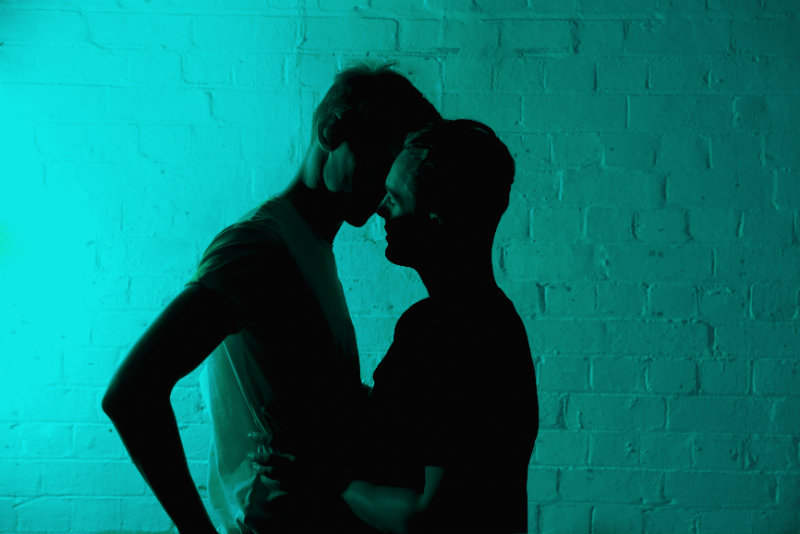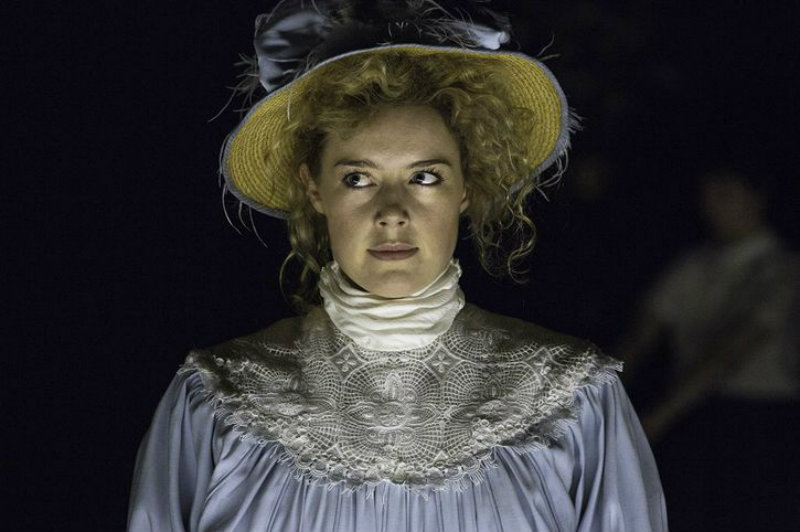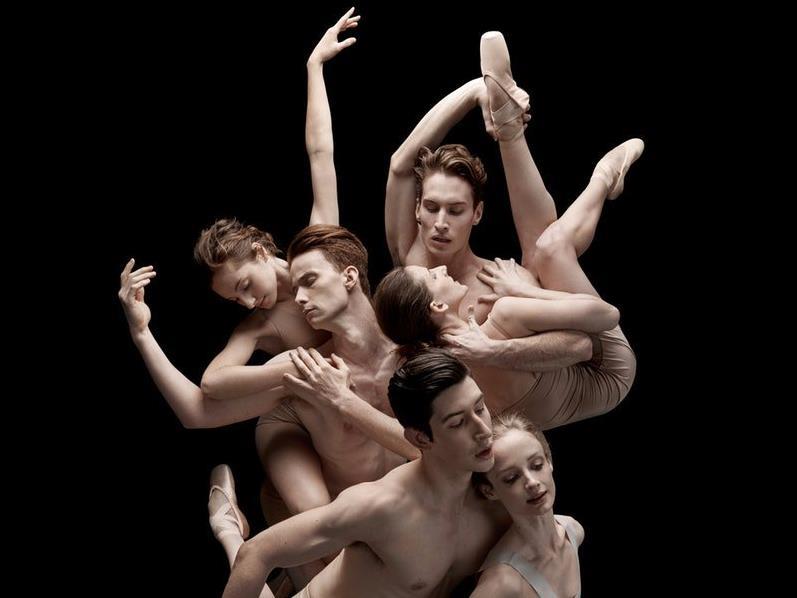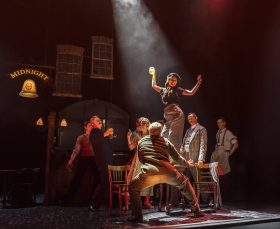Publicity image for The Australian Ballet’s Murphy, celebrating the works of iconic choreographer Graeme Murphy.
Artists in every sector invest considerable energy, both mentally and physically, in creating new work. Consequently, knowing when to down tools and step away from the finished object – if indeed an art work can ever be said to be finished – can sometimes be challenging, regardless of one’s medium or practice.
In the 19th century, for instance, English painter J. M. W. Turner was regularly known to rework paintings – sometimes significantly – even as they were hung for exhibition and often as his peers watched on.
As Turner’s contemporary, E. V. Rippingille, recorded:
‘Such a magician, performing his incantations in public, was an object of interest and attraction … For the three hours I was there – and I understood it had been the same since he began in the morning – he never ceased to work, or even once looked or turned from the wall on which his picture hung … Presently the work was finished: Turner then gathered his tools together, put them into and shut up the box, and then, with his face still turned to the wall, and at the same distance from it, went sidling off … All looked with a half-wondering smile, and Maclise, who stood near, remarked, “There, that’s masterly, he does not stop to look at his work; he knows it is done, and he is off”.’
But artists aren’t always the right people to recognise when a work is complete, according to playwright Tommy Murphy.
‘Maybe sometimes the artist might be the wrong person to ask,’ he mused. ‘There are stories of galleries refusing Bacon access to his paintings because he might slash them or try and alter them or something. Maybe the artist doesn’t always know.’
Murphy’s 2005 play Strangers in Between opens at Melbourne’s fortyfivedownstairs this week as part of Midsumma Festival, in a new production directed by Daniel Lammin. After its Melbourne season, the play transfers to The Seymour Centre for the Sydney Gay & Lesbian Mardi Gras.
A separate production of Strangers in Between is also currently playing in London’s West End, at Trafalgar Studios, follwing earlier runs at the smaller King’s Head Theatre in 2016 and 2017.
Murphy wrote the play 14 years ago, in 2004. After its world premiere season at Griffin the following year, Strangers in Between went on to win the 2006 NSW Premier’s Literary Award for Best Play.
So what does Murphy make of Strangers in Between now – and has he been tempted to rewrite the script for its 2018 revival?
‘I can’t tamper with it now, which is a lovely experience as a playwright – to look at a play knowing it’s sort of fixed. Actually, just today I cut a line, but I can’t rewrite it,’ he laughed.
‘Nick Hern Books in London published it recently and they offered me [the chance] to do some tinkerings and rewrites if I wanted to, and I found that I couldn’t. I’d be faking it because it’s not my voice any more. The perspective of the protagonist is now in the past and removed from who I am, so I realised that I mustn’t tamper.
‘Strangers in Between is now this fixed thing and I’m no longer the person who wrote it, so that makes it a finished work,’ he said.

Promotional image for Strangers in Between via www.fortyfivedownstairs.com
The story of a young gay man who flees his rural home for a new life in Sydney, Strangers in Between is now old enough that it’s essentially almost a period piece, Murphy explained.
‘There are circumstances in the story that can’t happen now. He doesn’t have a telephone, this kid who runs away from regional Australia to the city; he doesn’t even have a mobile phone. He would now.’
If the play were to be written today, not only would the lead character have a mobile, he’d also have access to hook-up apps like Grindr – which would significantly change the way the plot unfolds.
Even the play’s language has taken on a nostalgic tone, said Murphy – another reason why he views the script as a finished work rather than something fluid, to be rewritten and remoulded to reflect present-day concerns.
‘I hear words and think, “Oh, we used to say ‘full on’. We used to say ‘festy’. And I don’t hear those words anymore. It’s just far enough that you do notice the change and I think that’s interesting, that the gap is now enough to make it a period piece, unavoidably,’ he said.
It’s no picnic
Matt Lutton, Artistic Director of Malthouse Theatre Company, will soon be restaging his 2016 production, Picnic at Hanging Rock, in Melbourne before taking the play to London. Like Murphy, he too says it can be hard for an artist to know when a work is finished.
‘That’s a good question and I don’t really know the answer to it,’ he laughed. ‘I don’t know when [a work] is finished. I don’t know whether that’s a question for the audience or for the artist, really.’
What Lutton can say is that having space to reflect on a work definitely helps improve a production when the time comes to remount it.
‘In regards to Picnic at Hanging Rock, we’re constantly making small changes to it, so there’s a constant process of refinement … and obviously there’s a level of reflection you can have with a work that only happens when you get some distance from it,’ he said.
‘I think the chance to be able to, when it’s a piece of new writing, to be able to see multiple productions of it – or whether it’s actually being able to go back and not only remount a production you’ve done previously but also have a little bit of time to make adjustments – I think nearly always deepens it.’

Malthouse & Black Swan’s Picnic at Hanging Rock. Photo by Pia Johnson.
Following the original 2016 run of Picnic at Hanging Rock in Melbourne, the work – a co-production with Black Swan State Theatre Company – had a Perth season later that same year before opening in Edinburgh in early 2017.
Reapproaching the play has allowed Lutton and his cast to find more resonance in the work than ever before.
‘Almost without doing any rehearsals for nine months the show seems to be emotionally deeper, clearer and more in control, and that’s purely because of the fact that it’s had time to settle,’ Lutton said.
It’s also a rare opportunity, given how few Australian productions are restaged, for Lutton to finesse and fine-tune his own work.
‘I made some large changes when we did it in Perth and larger changes again in Edinburgh. When I say a large charge, I never know whether people know if it’s large or not,’ he laughed. ‘But they’re things for me that are important – I just don’t know whether other people will notice the change.
‘And a lot of the time I have made those changes because I wasn’t able to see the option the first time round. And also, once a show has found a rhythm, you can more easily identify those parts that are out of rhythm, so again a lot of that is about having the time to reflect on it and having the desire to try and perfect something,’ Lutton said.
Written on the body
Iconic Australian choreographer Graeme Murphy has a different approach to remaking older works, and does so with gusto.
‘I break into the museum of my works and frequently retouch things. The glass cover doesn’t protect them, I’m afraid,’ he chuckled.
‘It is fascinating, because I think choreography – because it deals with living humans in all their frailties, all their genius and their ever-evolving ability to do things more amazingly with every passing year – I think it is the most flexible and changing of the arts forms.’
Consequently, said Murphy, finessing older works – from 1979-80’s Shéhérazade to 2009’s Firebird, which will be staged by The Australian Ballet in March as part of their celebration of the choreographer’s oeuvre – is not only easy; it is a pleasure.
‘Choreography was made to evolve, I think. Every time you come back to a work, you might have 30 people in that work, or 50 people in that work, who have never danced it before – so reproducing something absolutely faithfully is really silly, and to try that is to deny creative dancers the right to put their stamp on a work,’ he said.
During his 30 years as Artistic Director of Sydney Dance Company, Murphy almost never remounted works. ‘At Sydney Dance Company we just made constant supplies of new works and rarely revisited works, because I was so obsessed with creating on the dancers who were in the company at the moment,’ he said.
Consequently, restaging his older works for The Australian Ballet’s season opener, Murphy, is a different and stimulating experience.
‘Doing some of the works from Sydney Dance Company on The Australian Ballet is a fascinating exercise. Because they have different techniques, different sensibilities, they’re a different generation … We’ll teach them the steps as they were created, but what they might add to them is sort of anyone’s guess at this point,’ he said.
As a choreographer, Murphy said it is important to honour and respect the unique qualities each dancer brings to a given role.
‘You have to allow flexibility within the way someone chooses to do something. It’s interpretation. I guess music is similar. If you have an instrumentalist who’s absolutely genius, they’re going to play the accurate notes but they are also going to bring something of their own colour to it, aren’t they?’
But while the collaboration between dancer and choreographer is important, so too is the discussion Graeme Murphy is having with himself, across time.
‘I think that what I try to do is to remember why I did something. And what the world was like when I did something – how that affected it. Because I feel like I’m a contemporary artist in that I respond to a contemporary situation, but I’m also responding autobiographically sometimes too, remembering who I was when I created those works back then,’ he explained.
‘Sometimes I look back at those early works and their naiveté is so deliciously honest. Or their bravery, because you didn’t know what could possibly go wrong so you just did whatever you felt instinctively at that moment. And sometimes you accumulate all sorts of paranoias, all sorts of knowledge that you recycle, as opposed to that beautiful blank canvas that you have when you’re very young and have no runs on the board. That’s a fascinating one for me.’
Given the size of The Australian Ballet and the demands individual works place upon dancers, often there are multiple casts working on the same production, a fact which Murphy also delights in.
‘You feel a very different energy from each of the three different casts. And that itself is the joy – that is what I love. The transience, the absolute freshness that people bring. And you know, every performance is like a great new discovery – not only for the audience but for the dancers themselves, because as they evolve in the work, as they feel more comfortable, they add layers. And it’s those layers that make the work special.’
For Graeme Murphy, remaking existing dance works on new dancers is not an act of recreation – it’s an act of creation, with the works made anew every night. Nor does he spend too much time thinking about how existing steps were danced in the past.
‘We might be longing for a quality that a dancer gave a work, because some of the dancers in Sydney Dance Company were so uniquely individual and their personalities permeated everything, but I consider that what we’re looking for now are similar people. Dancers who have that same adventurous quality and who want to push the boundaries, who want to push things further,’ he said.
‘I’m hoping that the dancers – because dancers evolve so quickly and the dancers now can do things that one only dreamed of when one was a young dancer … And, you know, you hope that that evolution of the dancer can be brought into play while still respecting that you’re not making a new dance for them – I’m giving them a dance that they should take ownership of.’
A different physicality
Cross-disciplinary artist and writer S.J. Norman, whose decade-old work Rest Area is being remounted for the Festival of Live Art later this year, has a different approach to the notion of revisiting work.
‘I don’t consider a performance to be a discreet moment that can be “revisited” or “restaged”. In making a work, I’m beginning a relationship with that work as an evolving entity unto itself, and that relationship is ongoing,’ Norman said.
‘Rest Area has been in performance since 2007, I’ve never retired it. During that time, the mechanics of the work itself haven’t changed much, if at all. What does change, continually, is my own body and psyche within that work.’
Rest Area takes place in the back of a stationary truck, and evokes one of our most intimate desires – the fundamental need to hold and be held in another’s arms.
The time that has passed since the work was first performed means that its upcoming Melbourne season will be akin to a musical collaboration or reinterpretation, with Norman entrusting the performance to the hands of another artist.
‘One major leap that Rest Area is making with this particular incarnation is that it’s now not just me who is performing it. For a few reasons, I’m coming to a point where I am interested in de-centralising my own performing body. After singing it solo for 11 years, Rest Area is a song that I’m ready to pass on to other performers,’ they said.
‘This transmission is an extension of my commitment to long duration, and to the work’s ongoing life. I’m also interested in how this might function as a critique of authorship and ownership and how this fits into broader political questions I’m engaged in. It’s an experiment – I have no idea how it’s going to go.

S.J Norman’s Rest Area. Photo by Gerwyn Davies.
Norman, who was trained initially as a Butoh dancer, said that they describe themselves as a body-based artist as well as a durational performer.
‘When I say I’m a durational artist, that doesn’t just mean I perform works that go for several hours. It means, potentially, that I perform works that go for several decades. The work itself is conversant with the passage of time as well as the shifting condition of the artist’s body and selfhood.’
Given the passage of time that has elapsed since Norman first developed Rest Area, they now have a different relationship with the performance – and indeed their own body
‘This work has been so deeply inscribed in me over years of performing it, I know it like I know my own skin. Though, for other reasons, I also feel very far away from Rest Area at this point. For one thing, when I made it I still considered myself to be a woman, and I performed it as a woman. It’s a deeply “feminine” work, however that might be defined, both in terms of the projections it invites from the audience and the type of energy the performer engages. If I can borrow, maybe clumsily, from a Doaist paradigm, it’s deeply Yin.
‘I began a process of gender transition about two years ago, which has deeply shifted my embodied relationship to a great deal of my existing works, Rest Area not least among them. In many ways stepping into the work now feels like wearing a dead person’s clothes. Negotiating that very profound change is just part of my ongoing relationship to the piece,’ Norman continued.
‘The process of transmitting both works to other performers is something that has emerged from these shifts. This is just what needs to happen now, and in many respects, it’s scary. It’s emotional. The results are something I can’t predict. But that’s how you keep the love alive.’
The Australian Ballet’s Murphy at Arts Centre Melbourne from 16-26 March and Sydney Opera House from 6-23 April 2018.
Picnic at Hanging Rock returns to Malthouse Theatre from 6-14 February 2018 before transferring to London’s Barbican Theatre from 21-24 February.
Rest Area at Arts House as part of the Festival of Live Art, 14-18 March 2018.
Strangers In Between plays fortyfivedownstairs from 24 January – 11 February 2018 and The Seymour Centre from 14 February – 2 March 2018.





